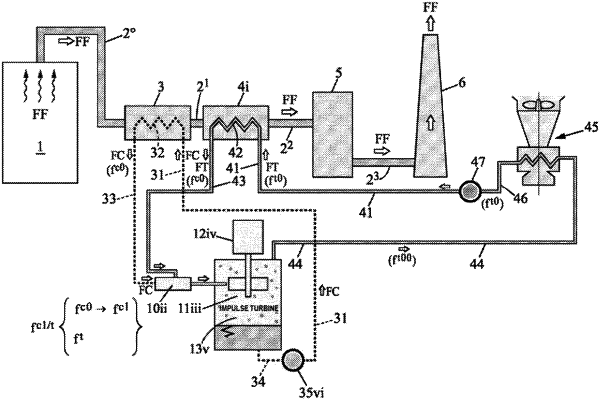| CPC F01K 21/005 (2013.01) [F01K 1/00 (2013.01); F01K 3/186 (2013.01); F01K 25/04 (2013.01); F01K 25/065 (2013.01); F22B 1/006 (2013.01)] | 18 Claims |

|
1. A method for converting thermal energy, contained in an at least partially gaseous waste fluid FF, into mechanical energy, said method comprising steps of:
I. utilizing a stream fc0 of an at least partially liquid heat-transfer fluid FC;
II. transferring thermal energy originating from the waste fluid FF to the stream fc0;
III. generating a fragmented stream fc1 of the heat-transfer fluid FC by spraying the stream fc0 heated in step II;
IV. in parallel to step III utilizing an at least partially liquid stream ft0 of a working fluid FT;
transferring thermal energy originating from the waste fluid FF to the stream ft0 to generate a stream ft having a temperature higher than a temperature of the stream ft0, wherein the working fluid FT in the stream ft is
i. in liquid phase;
ii. in liquid phase and in vapour phase;
iii. in saturated vapour phase; or
iv. in superheated vapour phase;
V. heating the stream ft to vaporize if the working fluid FT in the stream ft is not in the saturated vapour phase such that a vapour titre thereof is greater than or equals to 0.9;
VI. injecting the stream ft into at least one container also receiving the stream fc1 to form a dual-phase mixed stream fc1/t, a ratio Rd of a mass flow of the working fluid FT to a total mass flow of the heat transfer fluid FC and the working fluid FT being between 1 and 20%;
VII. accelerating and expanding the stream fc1/t;
VIII. converting kinetic energy of the accelerated stream fc1/t into mechanical energy;
IX. separating the working fluid FT and the heat-transfer fluid FC;
X. recovering an at least partially gaseous stream ft00 of the working fluid FT and an at least partially liquid stream fc0 of the heat-transfer fluid FC;
XI. compressing the stream fc0, and increasing circulation speed thereof;
XII. condensing the at least partially gaseous stream ft00 to the at least partially liquid stream ft0; and
XIII. compressing the at least partially liquid stream fc0, and increasing circulation speed thereof;
wherein the method further comprises implementation of at least one working fluid FT circulation loop and at least one heat-transfer fluid FC circulation loop, said loops sharing
i. at least one Injector-Mixer-Accelerator (IMA) in which the stream fc0 and the stream ft are intended to be injected/mixed/accelerated;
ii. at least one turbine to convert the accelerated stream fc1/t into mechanical energy; and
iii. at least one separator of the working fluid FT and the heat-transfer fluid FC;
and wherein the at least one working fluid FT circulation loop includes at least one heat exchanger between the working fluid FT and the waste fluid FF, at least one condenser of the working fluid FT, and at least one pump for circulating the working fluid FT in the at least one working fluid FT circulation loop; and
the heat-transfer fluid FC circulation loop includes a heat exchanger between the heat transfer fluid FC and the waste fluid FF, and at least one pump for circulating the heat-transfer fluid FC in the heat transfer FC circulation loop.
|